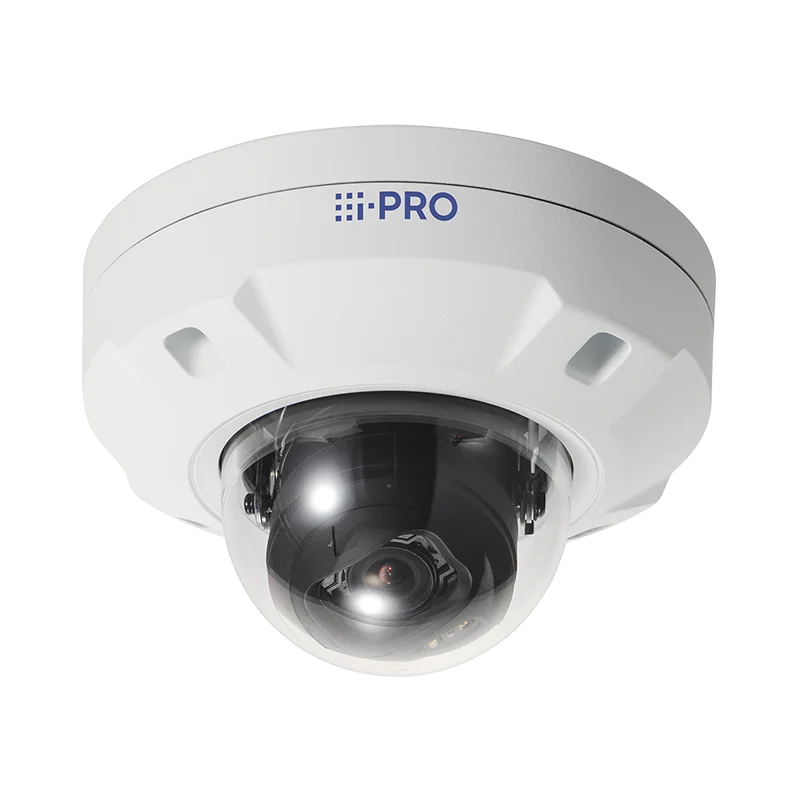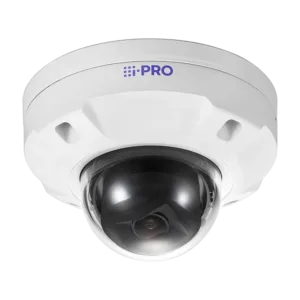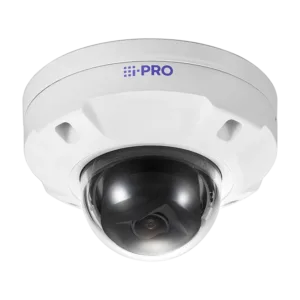WV-X22700-V2L i-PRO X-series dome camera with AI
I. Advanced Imaging and Visual Fidelity
The camera’s core imaging capabilities are built around an Approx. 1/1.8 type CMOS image sensor, providing a generous scanning area of 7.68 mm (H) × 4.32 mm (V). This substantial sensor size is pivotal for superior image acquisition and enhanced low-light performance.
One of the standout features is its remarkable Minimum Illumination performance. In color mode, the camera can capture clear images at an impressive 0.04 lux (30IRE, F1.5, 1/30s, AGC:11), and even as low as 0.004 lux with extended exposure (16/30s). For monochrome (BW) operation, the camera achieves true darkness surveillance with 0 lux when the IR LED is activated, otherwise reaching 0.03 lux, and an exceptional 0.002 lux with extended exposure. These figures highlight the camera’s ability to deliver high-quality video around the clock, regardless of ambient light conditions.
White Balance is precisely controlled with options like ATW1, ATW2, and AWC, ensuring accurate color reproduction across diverse lighting environments. The Shutter Speed is highly adaptable, ranging from a swift 1/10000 second to a fixed 1/60, 1/30, 1/50, or 1/25 second, depending on the selected frame rate mode (60 fps, 30 fps/15 fps, 50 fps, or 25 fps/12.5 fps). The Maximum Shutter extends to 16/30s or 16/25s, optimizing light capture for superior low-light imaging.
The camera incorporates intelligent image enhancement technologies such as Intelligent Auto (On/Off) for automatic optimization of various settings, and Super Dynamic (On/Off, with a range of 0 to 31). When Super Dynamic is active at level 31, the camera achieves a remarkable Dynamic Range of Max. 132 dB, crucial for rendering details in scenes with extreme light and shadow variations. Adaptive Black Stretch offers fine-grained control over dark areas, with an adjustable level from 0 to 255. Back Light Compensation (BLC) and High Light Compensation (HLC), adjustable from 0 to 31, are available when Super Dynamic or Intelligent Auto are off, effectively managing over- or underexposure from strong background or highlight sources. Fog Compensation (On/Off, range 0 to 8) further enhances visibility in adverse weather, available when Intelligent Auto or Auto contrast adjust are off. The Maximum Gain (AGC) can be set from 0 to 11, providing additional sensitivity in dim conditions.
The camera seamlessly transitions between color and monochrome modes via Color/BW (ICR), offering Off, On (with or without IR Light), and various Auto modes including Auto3 (SCC). Its integrated IR Illumination provides powerful night vision, with selectable levels (High/Middle/Low/Off) and a maximum irradiation distance of 70 meters (approx. 230 ft) at 30IRE and 50 meters (approx. 164 ft) at 50IRE. Digital Noise Reduction, with levels from 0 to 255, ensures clean, high-quality images by minimizing visual noise.
II. Advanced Detection and AI-Powered Analytics
Beyond standard video capture, this camera integrates sophisticated detection and analytical capabilities to enhance security and situational awareness. Video Motion Detection (VMD) allows for up to 4 configurable detection areas, triggering alerts upon specified movements. Scene Change Detection (SCD) provides alerts for significant alterations in the camera’s field of view within 1 designated area.
For audio monitoring, Audio Detection can be enabled. A highly valuable feature is AI Sound Classification, which can intelligently identify and differentiate sounds such as Gunshot, Yell, Vehicle horn, and Glass break, providing highly specific and actionable alerts.
The camera truly excels in its comprehensive suite of AI Analytics, leveraging artificial intelligence for a wide range of intelligent surveillance functions. These include AI Video Motion Detection, AI Privacy Guard, AI Face Detection, AI People Detection, AI Vehicle Detection, AI Non-mask Detection (prior to V3.30), AI Occupancy Detection, AI Scene Change Detection, AI On-site Learning, and AI Processing Relay. These advanced analytics enable more precise event detection, automated privacy protection, efficient subject identification, and adaptive learning capabilities. The camera’s open platform also supports a variety of 3rd party applications, further extending its analytical potential.
Privacy is a key design consideration, with the Privacy Zone feature allowing users to define and mask up to 8 configurable zones with various colors (gray, white, blue, green, red, black) or a mosaic pattern. VIQS (Variable Image Quality on Specified Area) is also available with up to 8 zones, enabling selective enhancement of image quality in areas of interest while optimizing bandwidth. For flexible installation, Image Rotation options include 0° (Off), 90°, 180° (Upside-down), and 270°. An integrated Image Stabilizer, utilizing a built-in gyro sensor, ensures steady footage, particularly in dynamic environments, and is available only in the 30 fps mode. Finally, a customizable Camera Title (OSD) can display up to 40 alphanumeric characters over 2 lines for clear camera identification.
III. Lens Specifications and Field of View
The camera’s lens system is engineered for both versatility and precise control. It features a 2.0x Motorized Optical Zoom and Motorized Focus, enabling convenient remote adjustment of the field of view and sharpness. An Extra Zoom capability extends up to a maximum of 12.0x, particularly beneficial when operating at lower resolutions like 640×360.
The Focal Length ranges from 4.3 mm to 8.6 mm, translating to a flexible Angular Field of View in 16:9 mode: Horizontal: 52° (TELE) – 101° (WIDE) and Vertical: 29° (TELE) – 55° (WIDE). This wide range allows for both broad overview surveillance and detailed close-up monitoring. The Maximum Aperture Ratio is 1:1.5 (WIDE) – 1:2.4 (TELE), indicating excellent light-gathering capabilities across the zoom range. The Focus Range extends from 1.0 meter to infinity, ensuring sharp images for subjects at various distances, and the Aperture Range can be set from F1.5 to close for precise depth of field control.
The camera’s practical surveillance capabilities are quantified by its DORI (Detect, Observe, Recognize, Identify) specifications:
- Detect (25ppm / 8ppf): Objects or people can be detected up to 63.3m (WIDE) and 157.5m (TELE).
- Observe (62.5ppm / 19ppf): General characteristics can be observed up to 25.3m (WIDE) and 63.0m (TELE).
- Recognize (125ppm / 38ppf): Familiar individuals can be recognized up to 12.7m (WIDE) and 31.5m (TELE).
- Identify (250ppm / 76ppf): Positive identification is possible up to 6.3m (WIDE) and 15.7m (TELE).
IV. System Architecture and User Interface
The camera’s high-performance capabilities are powered by the Ambarella CV52 System on Chip (SoC), a robust processor specifically designed for advanced video analytics and encoding tasks. Installation flexibility is paramount, reflected in the extensive Adjusting Angle specifications: a Horizontal (PAN) angle from -240° to +120°, a Vertical (TILT) angle from -30° to +85°, and an Azimuth (YAW) angle of ±100°. These wide ranges ensure optimal positioning and coverage.
User interaction and configuration are streamlined through a comprehensive Browser GUI, which supports a broad array of languages, including English, Italian, French, German, Spanish, Portuguese, Russian, Chinese, and Japanese. This intuitive interface is compatible with widely used web browsers such as Microsoft Edge, Firefox, and Google Chrome.
V. Network Connectivity and Data Security
Network integration is facilitated via a 10BASE-T/100BASE-TX RJ45 connector, ensuring standard Ethernet connectivity. The camera supports a broad range of Resolutions depending on the chosen frame rate mode. In 16:9 mode, it can achieve resolutions up to 3840×2160 (4K UHD) and 2560×1440, with additional lower resolutions available for 30 fps and 25 fps modes.
For efficient video transmission, the camera supports H.265/H.264 Transmission Modes/Types, including Constant bit rate, VBR, Frame rate, and Best effort, with Unicast and Multicast options. JPEG (MJPEG) Image Quality can be adjusted across 10 steps (0 to 9). Smart Coding features such as GOP (Group of Pictures) control (Off, Low, Mid, Frame rate control) and Smart VIQS (On/Off) and Smart P-picture control optimize bandwidth usage while preserving video quality.
Audio communication is robust, supporting Audio Compression Methods like G.726 (16 kbps/32 kbps), G.711 (64 kbps), and AAC-LC (64 kbps/96 kbps/128 kbps). Various Audio Transmission Modes are available, including Off, Mic (Line) input, Audio output, and Interactive (Half/Full duplex).
The camera supports a comprehensive set of Supported Protocols for both IPv6 and IPv4, ensuring broad network compatibility and secure communication. These include TCP/IP, UDP/IP, HTTP, HTTPS, SSL/TLS, SMTP, DNS, NTP, SNMP, DHCP, IEEE 802.1X, DiffServ, FTP, SFTP, LLDP, and MQTT. The camera can accommodate up to 14 simultaneous users, depending on network conditions.
Security is paramount, with FIPS 140-2 level 3 certification (via NXP® EdgeLock® SE050F), pre-installed GlobalSign® Device Certificates, HTTPS, user and host authentication, IEEE802.1X, system and image transmission logs, brute-force protection, alteration detection, secure boot, and signed firmware, all contributing to a highly secure surveillance solution.
For local storage, an SDXC/SDHC/SD Memory Card slot is available, supporting microSDXC cards up to 512 GB. The camera is compatible with Mobile Terminals running iOS 8.0 or later and AndroidTM, and adheres to ONVIF® Profile G/S/T/M for seamless integration with other surveillance systems.
VI. Alarm Management and Input/Output Interfaces
The camera’s Alarm system is highly versatile, triggered by a range of Alarm Sources including VMD alarm, SCD alarm, Command alarm, and Audio detection alarm. Configurable Alarm Actions include SDXC/SDHC/SD memory recording, E-mail notification, HTTP alarm notification, indication on the browser, and TCP alarm notification output, providing comprehensive alert mechanisms.
For external connectivity, the camera offers a ø3.5 mm stereo mini jack for Audio Input and another ø3.5 mm stereo mini jack for Audio Output (monaural), with an output impedance of approximately 600 Ω and an output level of –20 dBV. It also includes three versatile External I/O Terminals: ALARM IN1 (multifunctional for alarm input, black & white input, and auto time adjustment), ALARM IN2 (alarm input/ALARM OUT), and ALARM IN3 (alarm input/AUX OUT). A convenient Monitor Output (pin jack, NTSC or PAL signal) is provided for on-site adjustment and verification.
VII. General Specifications and Environmental Durability
The camera adheres to stringent international Safety and EMC standards, including UL (UL62368-1), c-UL (CSA C22.2 No.62368-1), CE, IEC62368-1, FCC (Part15 ClassA), ICES-003 Issue 7 ClassA, EN55032 ClassA, and EN55035, ensuring global compliance.
Power is supplied via either DC12 V or PoE+ (IEEE802.3at compliant). Power consumption remains efficient, at approximately 14.2 W (DC12V) and 14.0 W (PoE+), classifying it as a Class 4 device.
Designed for robust operation in various climates, the camera functions within an Ambient Operating Temperature range of -10 °C to +50 °C (14 °F to 122 °F), with a power-on range of 0 °C to 50 °C. It tolerates an Ambient Operating Humidity of 10 % to 90 % (non-condensation). The camera also boasts significant Shock Resistance with an IK10 (IEC 62262) rating, indicating high vandal resistance.
Physically, the camera has Dimensions of ø129.5 mm × 102.5 mm (H), with a dome radius of 41.5 mm. Its approximate Mass is 820 grams (1.9 lbs). The durable Finish includes an aluminum die-cast main body in i-PRO white and a clear PC resin dome cover, ensuring both aesthetic appeal and long-term resilience.









Reviews
There are no reviews yet.